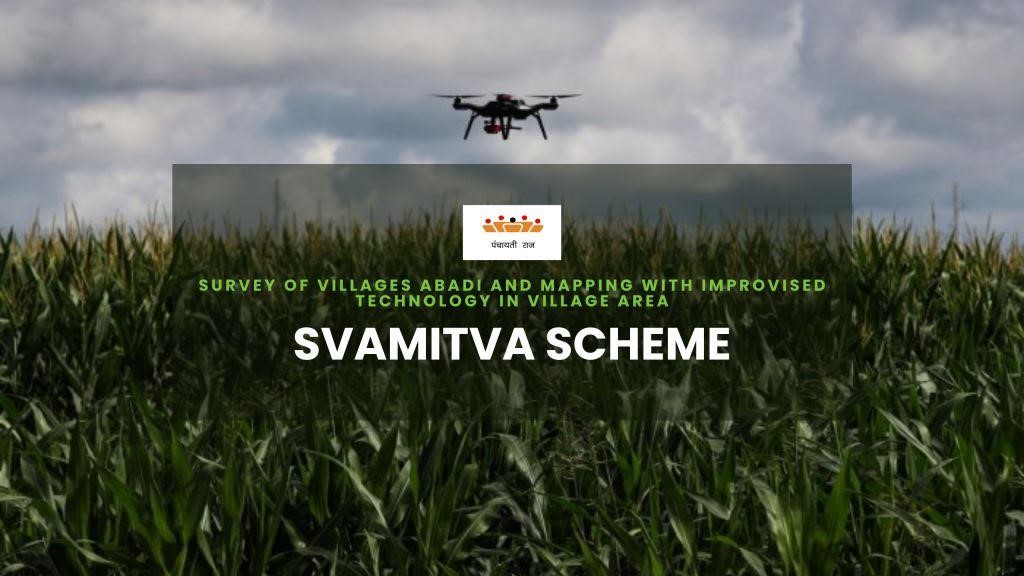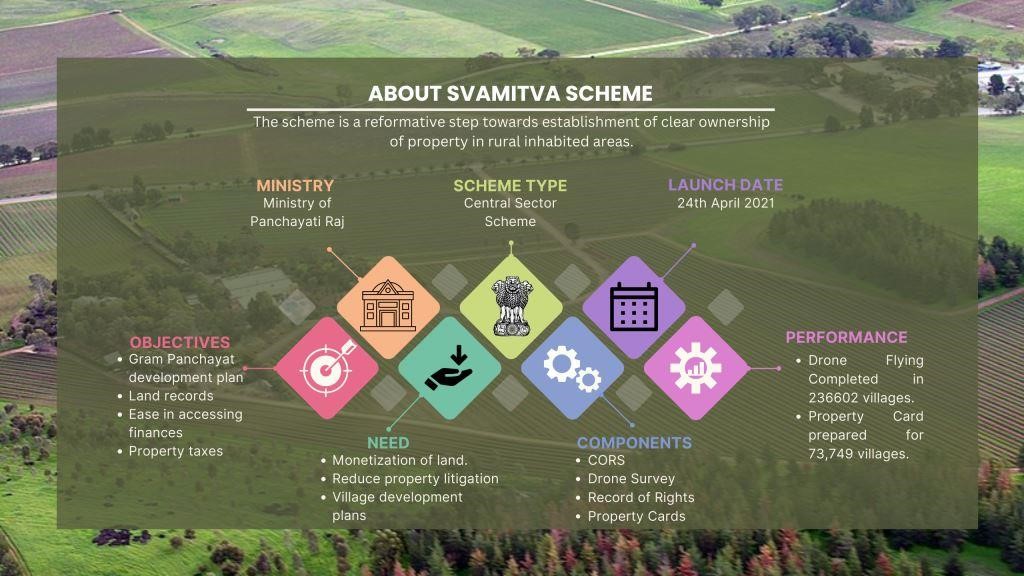29 Mar SVAMITVA SCHEME
Svamitva Scheme (Survey of Villages Abadi and Mapping with Improvised Technology in Village Area)
This article covers “Daily Current Affairs for UPSC” and the topic details the Svamitva Scheme. The topic “Svamitva Scheme” has relevance in the Governance section for the UPSC CSE exam.
Relevance of the Svamitva scheme
For Prelims:
- Features of the Svamitva Scheme
- Ministry operating the scheme
For Mains:
- GS 2: Government Schemes
- Role of Technology in Agriculture
- Performance of the Svamitva Scheme
- Challenges related to the Svamitva Scheme
Why in the news?
Recently Union Minister of State for Panchayati Raj in a written reply in Lok Sabha highlighted the achievements of the SVAMITVA scheme. The answer listed the State-wise details of villages covered and beneficiaries impacted.
What is the SVAMITVA scheme?
SVAMITVA scheme is a central sector scheme launched by the Ministry of Panchayati Raj in 2021. The scheme is revolutionary and reformative in its approach. It aims to establish clear ownership of property in rural inhabited areas.

Svamitva Scheme
What is the need of launching the SVAMITVA scheme?
There are property disputes in the villages because of the lack of ownership documents which leads to lengthy litigation. It also impeded the sale of a property because of a lack of legal titles. To bring a solution to his problem the scheme has been launched which aims to provide a ‘Record of Rights’ to land owners in the village by issuing legal ownership cards. The SVAMITVA scheme is in the direction to achieve “Gram Swaraj” and bring a positive transformation in rural areas.
The SVAMITVA scheme focuses on the following problems in rural areas:
- Monetization of land in villages and its subsequent use as collateral for taking loans.
- Reduce property-related litigation.
- Aiding a comprehensive village-level developmental planning.

svamitva project
What are the objectives of the SVAMITVA scheme?
The SVAMITVA scheme aims to fulfill the following objective.
- Gram Panchayat development plan: Preparation of villages level Gram Panchayat development plan by making use of GIS maps.
- Land records: Creation of accurate land records and curbing the related property dispute as a result of ambiguity.
- Ease in accessing finances: Financial empowerment by making land a monetized commodity.
Property taxes: Creating grounds for property tax which can be imposed in the presence of verifiable land records.
What are the components of the SVAMITVA scheme?
The SVAMITVA scheme has several components that aim to establish clear ownership of property in rural inhabited areas in India. The main components of the scheme include:
- Continuous Operating Reference System (CORS): This network would help in earmarking the location and provides extremely high 5-centimeter level accuracy. It supports accurate various geo-mapping techniques like – geo-referencing, ground truthing, and demarcation of lands.
- Drone Survey: Mapping of rural land parcels using drone technology to establish property boundaries and identify ownership.
- Record of Rights: Provide a “Record of Rights” to village household owners, which will include details such as property ownership, area, and location.
- Property Cards/Title Deeds: Issuing legal ownership cards (Property Cards/Title Deeds) to property owners that will serve as proof of ownership, facilitate monetization of property, and enable bank loans.

Svamitva card
What has been the performance of the scheme to date?
The SVAMITVA scheme makes use of drones to identify and demarcate land areas. Upon completion of the drone survey, it issues property cards. The recent data as submitted by the Union Minister of Panchayati Raj in Lok Sabha is given below:
- Drone Flying Completed in villages: 236602 villages
- Property Card Prepared:
- Villages: 73,749
- The number of Property cards prepared: 1,22,82,482
What are the challenges in the successful implementation of the SVAMITVA scheme?
The successful implementation of the SVAMITVA scheme faces various challenges, some of which are:
- Limited awareness among villagers: One of the major challenges in the successful implementation of this scheme is the limited awareness among villagers regarding the benefits of the scheme and the process of property registration.
- Technology-related issues: The use of drone technology for mapping rural land parcels is a crucial component of the scheme. However, the successful implementation of this component is dependent on the availability of skilled personnel and the quality of the technology used.
- Availability of data: The scheme requires accurate and up-to-date data to be collected and maintained. However, in many rural areas, data collection, and maintenance systems are not well-established, leading to challenges in the implementation of the scheme.
- Funding and resource constraints: The implementation of this scheme requires significant financial and human resources, which may be a challenge for some states and villages.
- Disputes related to property ownership: This scheme aims to reduce property-related disputes. However, in some cases, disputes related to property ownership can be complex and challenging to resolve.
Way Forward
Overall, the successful implementation of the scheme requires the collaborative efforts of various stakeholders and the effective resolution of these challenges. The following actions can be taken up to address the deficiencies related to the scheme:
- The legal validity of the property cards is unclear: The state government must ensure that the property cards issued must have legal sanctity.
- Capacity development of officials: This is to ensure that the record-keeping practices are streamlined
- Empowerment of the Gram Pacnahyats: This is necessary to make sure that suitable amendments are made to enable the collection of property tax.
- Grievance redressal system: Creation of a responsive grievance redressal system for swift disposal of disputes.
- Inclusion of the vulnerable communities: This is needed so that the rights of the people belonging to these groups are reflected in the updated “Record of Rights”.
In a nutshell, the SVAMITVA scheme with its reformative and revolutionary objectives can provide respite to the people in the villages who have been entangled in property disputes for generations.
Source:
Daily Current Affairs for UPSC
Get Daily Current Affairs for your UPSC exam preparation from Plutus IAS and read them for your IAS exam preparation. Also, read weakly and monthly current affairs from us. You can gain a broadened knowledge of the national and international world by reading these current affairs.
Download the PDF now:



No Comments